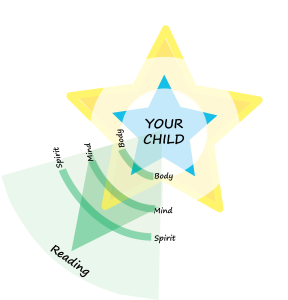Reading


Reading is all that you know it to be, and more. It requires competence in language. It is the skill of decoding written symbols, as well as discovering the meaning ‘behind’ the symbols. Reading includes sight word recognition (or tactile word recognition for Braille); phonological awareness; knowledge of the alphabetic principle; memory for sound-symbol correspondence, phonological, orthographic, and morphological pattern recognition; decoding; and word identification automaticity.
The Reading Body
Reading relies on healthy eyes, ears, and in the case of Braille, finger pads. When reading with your eyes, reflected light or emitted light in the color of the word enters your eye through your pupil and hits your retina. Your retina registers the color, and then sends the information through retinal nerve fibers and the optic nerve to the brain. Muscles of the iris control the amount of light entering through the pupil. Other muscles thicken or narrow the lens so you can focus on words of varying sizes and distances. The muscles and other tissues that surround the eye in its bony socket work together so you can track words in sequence.
You might think you don’t read with your ears, and, well, you’re right. But reading requires that you have previously heard the sounds that make up the letters and then stored them in your brain. You need to translate the graphic code into an acoustic code (letter-to-sound conversion) and link it with the processing system required for speaking. Then you will recognize the auditory patterns as words and be able to interpret what they mean. So how do people who are deaf learn to read? Well, the graphic code (letter combinations) has to translate into the visual representation of language that they learned for communication, such as sign language.
In the case of Braille, the same process is involved, except a tactile code instead of a graphic code is used. When reading Braille, receptors of pressure and proprioception transmit information via sensory nerves through tracts in the spinal cord and into the brain.
In order for everything to work efficiently, it’s important that all of the interacting body systems are functioning (nervous, musculoskeletal, circulatory, respiratory, gastrointestinal, integumentary, urinary, reproductive, immune, and endocrine). If some areas are weak, the body can compensate, but the extent of the adjustment needed does proportionately affect the accuracy, speed, and comprehension of reading.
The Reading Mind
The Reading Mind involves complex processes in the brain, and only an appropriately sophisticated theory will explain how it works. I’ve simplified things anyway with an illustration of how the Reading Mind works. You can download it here for free:
The Reading Spirit
The Reading Spirit is vital for personal growth. It helps you get absorbed in material that makes you feel alive. The words might offer you healing, inspiration, peace, insight and guidance, on a soul level. You might get clarity of intention and purpose and become more aware of what gets in the way of harmony.
The reading spirit allows you to open your mind so that you can better understand your soul. It heightens your consciousness to live the essence of who you are and to be of better service to others. Poetry, songs, letters, the bible, inspirational quotes, and affirmations are all sources that engage the reading spirit.
If you are a parent, grandparent, or other caregiver and want to encourage a child to grow in speech, language or literacy development, the Reading and Speech Clinic can help. Let’s begin by email by signing up for a free mini-assessment. By participating, you will discover your child’s precious gems in the areas of Talking, Listening, Expressing, Reading, Writing, Mind, Body, and Spirit. You will find out which gems are currently shining in your child, and which ones might need a bit more polishing. Start
